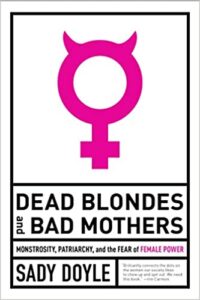Dead Blondes and Bad Mothers: Monstrosity, Patriarchy, and the Fear of Female Power by Sady Doyle
Melville House Publishing, 2019
ISBN-13 : 978-1612197920
Available: Paperback, Kindle edition, audiobook
Sady Doyle has written a witty, chatty, insightful, and angry book on female monstrosity. Her premise is that women who claim ownership over their voices and bodies are constructed as monsters because they violate the social and biological norms that threaten men’s control over them- they are a threat to the patriarchy. Doyle identifies three key roles women fill in our patriarchal society and divides the book into sections on “daughters”, “wives”, and “mothers”. She has a lot to say about mothers: that section gets twice the number of pages as the other two sections combined.
Doyle has combed through pop culture, history, literature, fairy tales, myths, horror, true crime, sociology, and personal anecdotes to find examples and support for her theories, and when she does a deep dive into a topic (as she did on a number of girls and women, including Annelise Michel, Bridget Cleary, and Augusta Gein), or a critique of The Conjuring, it is fascinating and memorable. However, Doyle jumps around a lot, and it isn’t always clear how things are related. Her writing flows well, and she does a nice job making it relevant and tying it to recent events.
If you’re looking for an enjoyable feminist take on monstrous women, you’ve found it.
The book includes an annotated list of works cited, endnotes, and an index.
Recommended.
Reviewed by Kirsten Kowalewski
Sady Doyle’s premise is that female monstrosity is determined by patriarchy, which she describes as a social, cultural, and moral structure that is founded in men’s absolute power and control over at least one woman, generally through instilling fear in them. Doyle contends that women who claim ownership over their voices and bodies are constructed as monsters because they violate social and biological norms that threaten men’s control over them. She identifies three key roles women fill in our patriarchal society, and devotes a section of her book to “daughters”, one to “wives”, and one to “mothers”. She chooses from a variety of literary, legendary, historical, and pop culture examples and stories to discuss female monsters, both fictional and real, that exist outside society (or are ostracized by society), and the female victims of monsters that the patriarchy requires.





Follow Us!